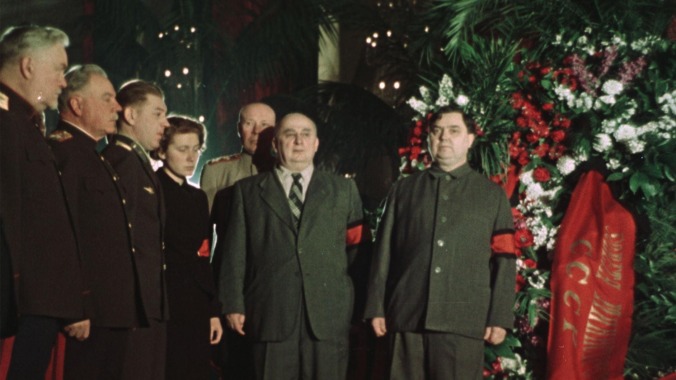State Funeral finds absurdities and metaphors in archival footage of Stalin’s wake


On a frigid day in March 1953, in a Moscow alley, middle-aged men in long dark coats carry a carnation-red coffin out the back of a small bus and into the back entrance of an austere building. A ballroom has been prepared with hot movie lights and prodigious wreaths, garlands, bouquets—an indoor jungle of floral arrangements, red, white, and green. The men huff and teeter as they exert themselves to lift the coffin on the bier. Young soldiers stand guard, staring off into nothing, trained to not acknowledge the physical comedy now going on behind them. At last, the coffin is in place, the lid is removed (it takes some effort), and we can see, via close-ups in color and black-and-white, its embalmed occupant: It’s Joseph Stalin. We are watching his memorial, with its weeping throngs and stilted lamentations.
Will the former USSR ever stop having to bury Stalin? This is the question ultimately asked by Sergei Loznitsa’s State Funeral, which was edited from almost 40 hours of footage filmed for the official record. It is all too easy to read Loznitsa’s selections as a series of visual metaphors, beginning with the opening sequence. What we are witnessing is not a lid being placed on an era but the opposite: the lid’s wobbly removal by historical figures who are, to most viewers, anonymous. The minimal onscreen text identifies only the locations and foreign delegates, an eternal course of handshakes and small-town ceremonies, radiating from the central event in Moscow, where Stalin’s chief hatchet man Lavrentiy Beria and heir apparent Georgy Malenkov stand awkwardly in poorly tailored clothes. Soon, Beria would be dead from a bullet to the head and Malenkov would be on the losing end of a power struggle.
Loznitsa—a Russian-speaking filmmaker who was born in Belarus, spent his early life in Ukraine, and has been based in Germany for two decades—has, in both his documentaries and in fiction films like My Joy and In The Fog, established himself as a chronicler of unresolved Soviet trauma and post-Soviet entropy. These are different facets of the same cultural phenomenon. In State Funeral, as in Loznitsa’s other archival documentaries about Stalin-era Soviet history (among them the classic Blockade and the recent The Trial), the paradox of a ubiquitous past is reflected in audiovisual design. The original footage, most of it silent and shot in the distinct palette of German Agfacolor, has been combined with new sound effects: coughs, wheezes, squeaking shoes.
Compared to Peter Jackson’s They Shall Not Grow Old, which attempted to make World War I footage “come alive” with sound and digital magic, Loznitsa’s method is intentionally demystifying. That isn’t to say that it doesn’t offer a window into history: Generations removed, any documented banality can offer an insight into life in the past. When it comes to unused B-roll, a sense of the absurd is inevitable. Even in the opening shot, the coffin being unloaded, we can spy a man fumbling to find the right key for the bus door. Mourners struggle to fit humongous wreaths through doorways or stand in position waiting for the cameraman to call action. A group of artists is positioned near Stalin’s coffin, working with paints and clay to rapidly execute official artworks of the memorial like a bizarre socialist-realist art class.
With a running time of 135 minutes, it eventually becomes exhausting—but that is partly the point of a film about a population going through the motions, of a mass event with a hole where the middle should be. We hear radio broadcasts with excessively detailed descriptions of Stalin’s pre-mortem medical conditions and long, risible poems about his superhuman kindness and genius. Stalin’s memory, it’s said again and again, will live on. But is it really Stalin, or a “Stalin” who could only exist in scare quotes?
The long reign of the man born Ioseb Jughashvili is often described as a cult of personality, which is a misleading concept. There was no charismatic persona behind the posters of a paternal Comrade Stalin, often pictured with soldiers or children. Out of all the world leaders of the 1930s and ’40s, he was easily the least gifted with the public. What Stalinist images legitimated more than anything was not the man in charge but the competing subsystems and political operatives that always seem to make up a single-party state’s fractious upper-management—the pallbearers who in more democratic circumstances would comprise an unelected deep state.
What Loznitsa is addressing is the rehabilitation of the Stalin era, specifically in Russia. Having shown the emptiness of the ceremony, he ends State Funeral on a sobering note with death tolls and statistics. Yet it is the mythic Stalin’s flimsy relationship to reality that makes rehabilitation possible: It allows one to believe that they are not rehabilitating Lavrentiy Beria, though the truth is that the exercise of power, even when nominally centralized in one figure in uniform, falls entirely on the schemers and flunkies.